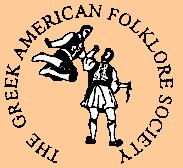Costumes: Epirus - Zagori
/The villages of Zagori that cling to the sides of Mount Pindos, and to which access was difficult to prevent invasion, developed undisturbed a high standard of living during the difficult years of Turkish occupation, when the inhabitants of the towns and plains were suffering considerable hardship. According to the earliest information available regarding their costume, it was a bourgeois style, originally oriental but later western in character. It was worn in 46 villages with some variations.
The flokata, the sleeveless overdress of the sigouni type is the only traditional feature of the costume. The other components of the dress have been influenced by the fashion prevailing at the end of the 19th century. Made of thick woolen fabric, theflokata was ornamented with red ribbons, panels of red felt and embroidered patterns of red twisted cord. The two rectangular panels of red felt at the sides of the overdress are calledspatela. The black apron is embroidered with bright flowers and the edge with knitted black lace on the hem. The jewelry is an ornamental belt-buckle. A black printed head-kerchief is tied in a special manner, known as oura mantili. In 1991, Paul Ginis traveled to the island of Tilos to conduct his research. Mr. Ginis observed the women still wearing this costume, signing their traditional songs and dancing their traditional dances.






